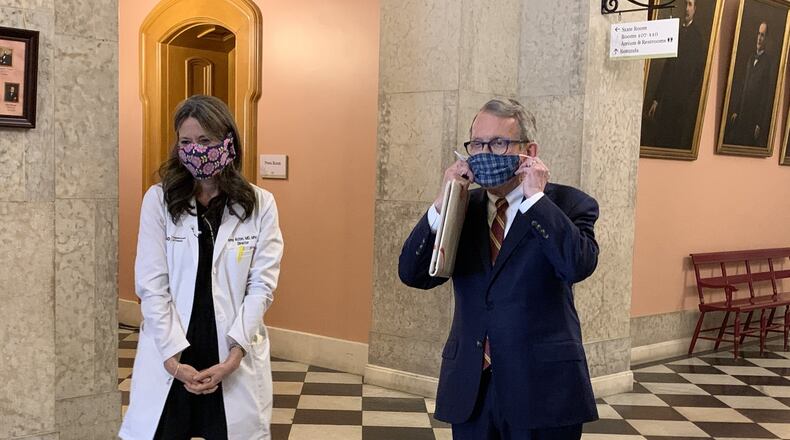>> Coronavirus: Complete Coverage
While other states have built new facilities and locations to treat sudden increases in other states, Ohio is utilizing existing buildings.
Ohio Department of Health Director Amy Acton said the most severe cases will still be treated in the hospitals.
Ten inmates and 27 staff have tested positive for coronavirus in Ohio prison facilities, DeWine said.
The 10 inmates are in Marion and Pickaway counties. The staff are at four different facilities, but mainly are at the Marion County facility.
All prison staff is being screened when they arrive and their temperatures are being taken, DeWine said. Anyone with symptoms of the virus are being tested.
>> Local defense contractor devises COVID-19 face shields for anyone
More details about the state releasing nonviolent inmates will be released Tuesday, the governor said.
Three inmates have died and seven have tested positive at Elkton Federal Correctional Institution in Ohio, said DeWine.
As a result, the governor has authorized the Ohio National Guard to go to the prison to assist for seven to 10 days until more federal assistance can arrive.
Those members will have N95 masks to protect them as they assist. DeWine stressed that it is only a medical mission and that guard members will not be armed or provide security.
Because it is a federal prison, Ohio does not have the authority to release any inmates.
However, DeWine said he’s asked the U.S. Department of Justive and Federal Bureau of Prisons to stop intake of prisoners at the facility.
>> Coronavirus: If someone is sick, what should household members do?
The state is continuing to increase its supply of surgical masks and other personal protective equipment, DeWine said.
They are buying any supplies that they can and if they can’t find, it’ll be made locally, the governor said.
DeWine elaborated on a new order going into effect at midnight, extending the stay-at-home order to May 1.
One of the new provisions requires stores to determine how many people can be in the store while practicing physical distancing and to post that number. DeWine noted that some stores have already started posting those numbers and that others have started going toward one-way aisles.
The Ohio Department of Health is reporting 142 deaths and 4,450 cases of coronavirus in the state.
There have been 1,214 hospitalizations and 371 ICU admissions.
While 52% of cases are females, deaths have been higher in males, Acton said.
Cases/deaths by race and ethnicity in #Ohio. ⬇️ 25% of cases don't have race listed, and 39% don't list ethnicity. So, we know some people are opting out of providing that information. We are working to capture this data as best we can. We encourage people to fill in that data. pic.twitter.com/T9jh25oRKb
— Governor Mike DeWine (@GovMikeDeWine) April 6, 2020
Of the state’s cases, 51% of those who tested positive are white, 18% black and 2% Asian, 2% multiracial and 2% other. Acton noted that in 25% of cases race is unknown due to people leaving that section blank on intake forms.
Likewise, when looking at cases by ethnicity, 58% are non-Hispanic or non-Latino, 39% unknown and 2% Hispanic or Latino.
Acton stressed that Ohio does not want to leave anyone behind when getting through this pandemic.
Once widespread testing is available, she said it’s crucial to do so in a way that provides an accurate picture of race, ethnicity, disability, age and those people with life-threatening illnesses.
.@LtGovHusted - This map is a source of optimism. If you sacrifice now, you'll see the dividends later. Red shows people who are still traveling. On gray side, the more that people have been compliant with #SocialDistancing. pic.twitter.com/QscZ8Ni7C5
— Governor Mike DeWine (@GovMikeDeWine) April 6, 2020
Lt. Gov. Jon Husted shared a map from The New York Times showing that Ohioans have decreased travel outside the home.
He called the map a source of “optimism” for the state and that it shows Ohioans have been compliant with social distancing.
DeWine reminded Ohio “snow birds” who travel south for the winter and are now returning to the Buckeye State that they must self-quarantine for 14 days.
He asked that friends and family help anyone returning to Ohio and bring them food and other supplies they may need to get through the quarantine period.
However, he noted that Ohioans need to continue social distance.
RELATED CONTENT:
>> CANCELED: We won’t be celebrating these Dayton-area festivals this year
>> Ohio liquor sales increase during coronavirus pandemic
>> Fairborn distillery converts $100K worth of rum into hand sanitizer for WPAFB
>> Coronavirus: UD community shows support for essential workers with signs



